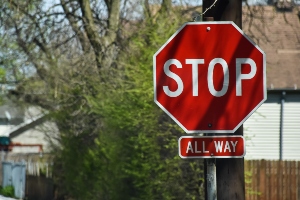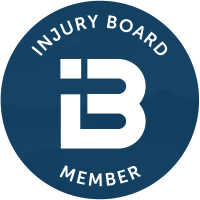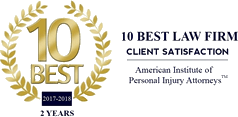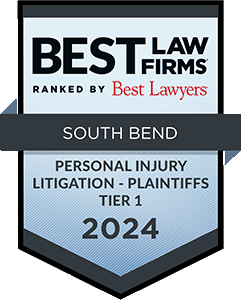 Four-way collisions can happen in numerous ways and result in serious injuries. Drivers may have failed to yield the right of way or been distracted while crossing an intersection.
Four-way collisions can happen in numerous ways and result in serious injuries. Drivers may have failed to yield the right of way or been distracted while crossing an intersection.
Below, Pfeifer, Morgan, and Stesiak explain more about four-way stops, including Indiana laws regarding four-way intersections and who may be liable. We also discuss steps you can take to avoid collisions at these types of intersections.
If you suffered injuries at a four-way stop intersection, you may be eligible to seek compensation for damages and injuries. Our South Bend car accident lawyers are prepared to help you with the legal process. There are no upfront costs or fees to pay.
Call our office today at (844)-678-1800 to request a FREE case review.
What Are Indiana Laws for Four-Way Stop Signs?
Indiana law mandates that every driver comes to a complete stop at a stop sign. In intersections with two or more stop signs, the driver should yield to the vehicle that arrived first.
When two vehicles arrive at a stop sign simultaneously, drivers on the left side should yield the right of way to drivers on their right. Additionally, drivers must yield to pedestrians and bicyclists crossing intersections.
What Are the Common Causes of Four Way Stop Sign Accidents?
Four-way stop sign accidents can result from distracted driving, or at any time a driver fails to come to a complete stop. Speeding drivers may not have enough time to stop, increasing the risk of a side-impact collision or other types of accidents.
Other factors contributing to four-way stop sign accidents include:
- Drivers lacking knowledge of four-way stop sign rules, particularly if they are inexperienced.
- Reduced visibility due to adverse weather conditions or poorly maintained intersections.
- Drivers operating under the influence of drugs or alcohol.
- Miscommunication through hand signals or eye contact.
- Aggressive driving behavior, such as trying to outpace other drivers at intersections or creating potentially dangerous situations by laying on the horn or shouting out the window.
Who May Be Liable for a Four-Way Stop Accident?
Drivers failing to yield the right of way are often liable for accidents. They may be considered negligent for failing to obey posted traffic signs by coming to a complete stop.
Other factors that may provide additional insight into who may be at fault for an accident include:
Comparative Fault
Accidents involving multiple parties could lead to shared responsibility. In this situation, two or more drivers could be held liable for a percentage of the damages if a claim is filed.
Government Entities
Government entities may be held responsible for accidents caused by poor road conditions. However, crash victims or their attorneys must be able to prove that the authorized entity knew or should have known about the poor road conditions and failed to take appropriate corrective measures.
What Type of Evidence May Help To Prove My Case?
Determining liability in a four-way stop sign crash may pose certain challenges. Evidence plays a crucial role in establishing liability.
Key evidence may be pulled from various elements, including:
Police Statement
When police arrive at a crash scene, they investigate vehicle damage and gather statements from all drivers to determine how the accident may have occurred. Drivers should provide honest, but concise answers. However, it is best not to ramble on or talk about things you only think may have happened. What you say gets documented in the police report, and your statements can later be used as evidence.
Crash Scene
Crash investigators examine various elements at the accident scene and other related evidence, including:
- Road condition, such as the presence of ice, rain or potholes
- Brake failure or other mechanical issues that could have contributed to the crash
- Vehicle maintenance history
- Traffic surveillance camera footage
- Skid marks – or the absence of them
- Weather at the time of the crash
Witness Statements
Statements from witnesses present at the scene can help to establish the chain of events. Obtaining these statements promptly is crucial, as memories may fade over time. Small details witnesses remember right after a crash could be vital to your claim.
Photos and Videos
Visual evidence, such as photos and videos of damage, may help to illustrate what caused the crash. It could also give insight into how fast the vehicles were traveling at the time of impact. Documenting the vehicle’s post-crash position may give additional clarity about how a crash occurred.
Can I Receive Compensation if I Am Partially at Fault?
Car crash victims may be eligible to seek compensation even if they share partial fault. However, they must not be more than 50 percent liable. If eligible to seek compensation, any settlement awarded will be reduced by your percentage of fault for a crash.
Injury claims can be complex and challenging to prove, which is why we recommend consulting with a lawyer for guidance. An experienced attorney can help to ensure you are not assessed with more than your share of liability.
What Type of Compensation Can I Seek for Injuries and Damages?
Compensation from a car accident is aimed at helping victims recover. The types of compensation that may be available include:
- Medical expenses: All reasonable and necessary medical costs related to the crash, including hospital bills, doctor visits, surgeries and ongoing treatments.
- Property damages: Addressing vehicle and property damages, including repairs or replacements.
- Loss of wages: income lost due to missing work while recovering from injuries
- Pain and suffering: Non-economic damages are harder to prove but may include physical pain, emotional distress, post-traumatic stress disorder (PTSD), mental suffering and more.
- Loss of consortium: Another type of non-economic damages helps victims recover compensation for any loss of companionship, intimacy and support resulting from accident injuries.
- Funeral and burial: Funeral, burial and related costs resulting from fatal car crashes.
What Can I Do To Avoid a Crash at a Four-Way Stop?
Drivers can avoid getting into a car crash by following road signs and paying attention to other nearby vehicles. Here are some good practices that drivers can implement to help prevent four-way stop collisions:
- Bring your vehicle to a complete stop.
- Look to see which vehicle, including yours, entered the intersection first, and yield the right of way.
- Even if you have the right of way, look in all directions before driving across an intersection in case another driver fails to yield.
- Use turning signals to communicate with other drivers.
- Check for and yield to pedestrians and bicyclists.
- Be patient when arriving at intersections.
- Maintain a good distance between your vehicle and the one in front of you to prepare for sudden stops.
Contact Our South Bend Office To Discuss Your Case Further
If you were injured in a car accident, it is important to make your health your priority. Visiting a nearby emergency room could help you to get diagnosed and treated for your injuries sooner.
While you focus on your recovery, our attorneys are prepared to work tirelessly to help you get the compensation you need.
At Pfeifer, Morgan, & Stesiak, we are committed to seeking the maximum compensation for your medical expenses, property damages and more. There are no upfront costs if you hire our firm. We only get paid if we recover compensation for you.
Proven results. Millions recovered. (844)-678-1800











